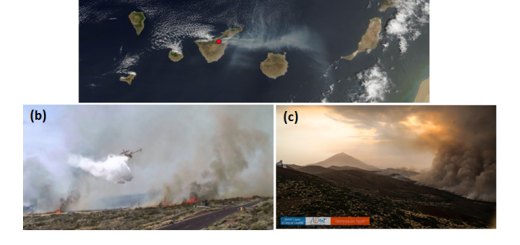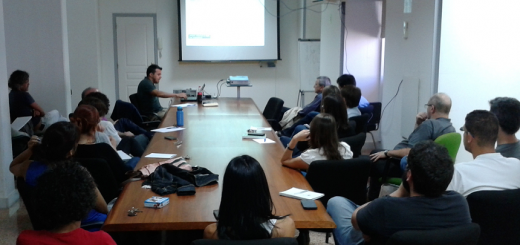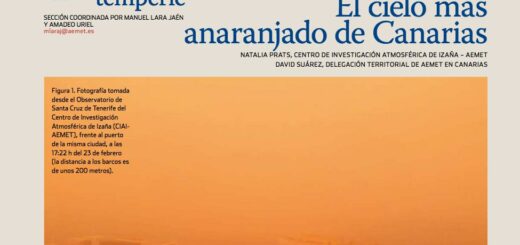International day for the Preservation of the Ozone Layer. The Izaña Atmospheric Research Centre contribution

The International Day for the Preservation of the Ozone Layer has the theme “Ozone: Everything is between you and the UV rays,” and focuses on disseminating the effects on human health has had the decreasing ozone layer and consequences had the subsequent adoption of the Montreal Protocol. The role of the Izaña Atmospheric Research Centre (CIAI) of the State Meteorological Agency (AEMET) focuses on monitoring and research on the ozone, on one hand, providing high quality measures that feed and check the models on which these studies are based, and estimating trends both ozone and ultraviolet radiation and, on the other hand, contributing to understanding the processes influencing trends focused on the subtropical region.
The CIAI is the Regional Ozone Calibration Centre (RBCC-E) providing calibration to the Brewer spectrophotometers in Europe and North Africa. Since 2011 RBCC-E transferred its own calibration, obtained by absolute calibration, the rest of the network at regular campaigns financed by the European Space Agency (ESA). The RBCC-E also participates in training activities and the development of new technologies associated with the observation of ozone. The Izaña Observatory is one of the reference measurement stations worldwide gathering the most precise measurements of ozone instruments: Brewer, ozonesondes, DOAS and FTIR, the latter in cooperation with the National Institute of Aerospace Technology (INTA) and the Institute for Meteorology and Climate Research (IMK, Germany), respectively. These measures belong to the Global Atmosphere Watch program (GAW) of the World Meteorological Organization (WMO) and the network of excellence “Network for the Detection of Atmospheric Composition Change (NDACC).
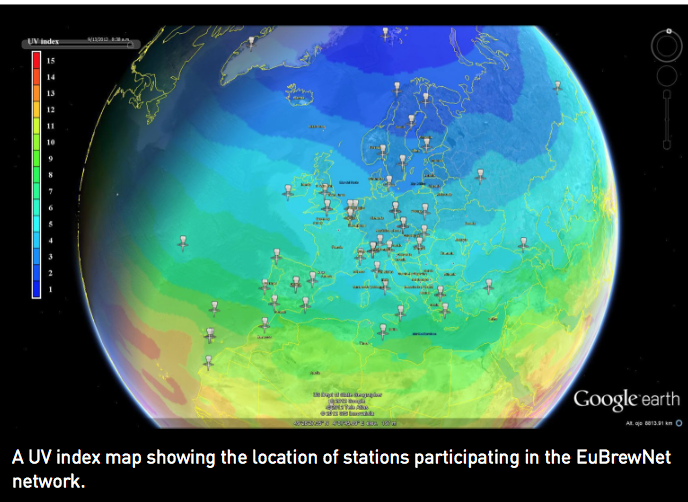
Figure 1: On the map of UV index obtained by the OMI satellite stations participating in the network are shown EUBREWNET newly stations have joined the United States, Canada and Australia.
AEMET co-leads EBUREWNET European COST action, which aims to facilitate consistent and evenly measurements of ozone, spectral UV, and aerosol optical depth provided by Brewer spectrophotometers deployed in Europe. In this project, in which 18 European countries are involved, the United States, Canada and Australia have joint. Scientists involved in EUBREWNET work together to increase the characterization and calibration of instruments, as well as the process and quality control of observations. The database project is hosted by AEMET where observations are received and processed in real time in a centralized manner. This database gives European response to the demand of organizations such as the World Meteorological Organization, the World Data Center Ozone and Ultraviolet (WOUDC, World Ozone and UV Data Centre), the Intergovernmental Panel on Climate Change (IPCC, Intergovernmental Panel on Climate Change), and the GMES (Global Monitoring for Environment and Security) of the European Union, for monitoring the Earth and atmosphere.
Another important contribution to the international ozone program is the Alberto Redondas, Head of the Ozone and UV radiation Program at Izaña, membership of the WMO Scientific Advisory Group for Ozone (SAG-Ozone).
In collaboration with the group of intelligent-sensors of La Laguna University (ULL), the RBCC-E participates in ATMOZ project led by the World Radiation Center (Switzerland), which aims to improve the accuracy of ozone measurements. Also in collaboration with this group, the EGB-SVN project (funded by the European Space Agency (ESA)) is developed, where the CIAI is the central calibration Lab of PANDORA spectrophotometers (Pandonia network). This instrument, recently developed by NASA, besides providing ozone measurements, provides measurements of NO2, SO2 and aerosols optical depth used to validate the EarthCare satellite sensor. The ULL, in collaboration with AEMET, provides calibration services to radiometric sensors of Luftblick and Kipp & Zonen companies, which produce Pandora and Brewer spectrophotometers, respectively. These instruments measure atmospheric ozone and are referenced to the RBCC-E Triad.
There is also close cooperation with North Africa (Morocco and Algeria). In Algeria, a Brewer spectrophotometer operates in the heart of the Sahara (Tamanrasset). Another important contribution is the membership of Alberto Redondas, Ozone and UV radiation Program of the CIAI, to the WMO Scientific Advisory Group of Ozone (SAG-Ozone). Ozone related activities from CIAI also take place in Antarctica where, in collaboration with Spanish and Argentine institutions (National Antarctic -DNA- and -CADIC- Southern Research Center and the National Weather Service, INTA and AEMET) co-manages the ozonesonde station at Ushuaia (Patagonia Argentina). The RBCC-E supports ozone measurements of the Uruguayan Antarctic Institute in Artigas Base Station. In collaboration with the DNA and the FMI (Finnish Meteorological Institute) manages a multichannel radiometers at Antarctica for ozone and UV radiation measurements in Ushuaia, Belgrano and Marambio stations. At the moment this network, established in 2000, is under renovation.
The state of the ozone layer
The WMO 2014 ozone assessment presented last year reported as main conclusion that the recovery of the ozone layer was closely linked to the evolution of the concentration of the greenhouse gases that are causing climate change. The Montreal Protocol was very successful and ozone layer depleting gases are no longer emitted and are now slowly diminishing; their lifetime is so long that their concentrations since 1993 have only decreased by 15%. It is estimated that the ozone layer will recover by mid-century and its most dramatic manifestation, the Antarctic hole, will be recovered 25 years later. However, recovery of the ozone layer we are seeing is not only due to the decline ozone depleting substances. Recent studies show that this is also due to stratosphere cooling caused by climate change, and both factors contribute equally.
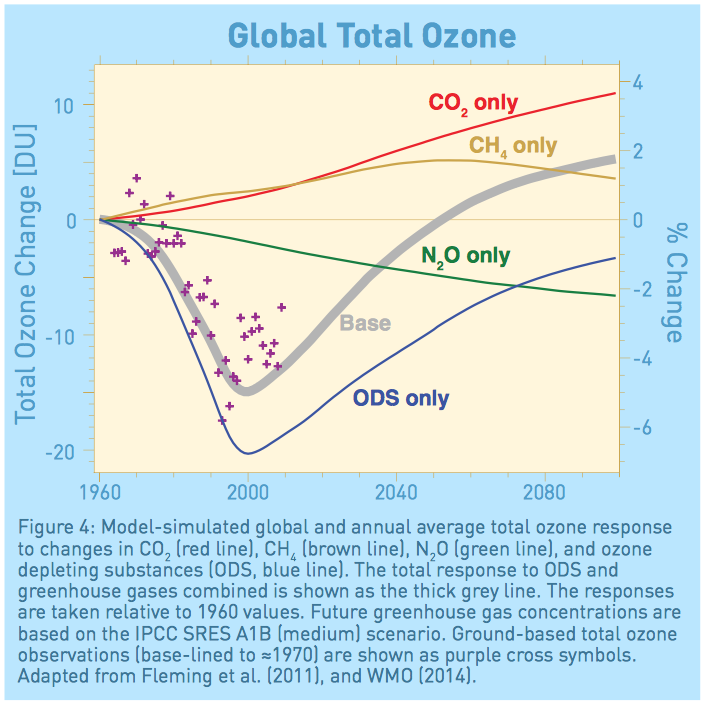
Effects on the environment
This year the United Nations Organization has published the report on the environmental effects of the ozone layer depletion and how it affects human health through changes in UV radiation. The main conclusions of the report are:
● The knowledge of the effects of the decline in the ozone layer has increased a lot in recent years and the scientific consensus is very high, but the estimation of the effects is very complex because of the three following aspects related with the problem: environmental (evolution of ozone, climate change), biological, with a long delay between exposure to UVR and its effects (decades) and, especially, of human behavior regards sun exposure (sun vacations, tan as standards of beauty ..).
● The adoption of the Montreal Protocol has avoided a major global collapse of the ozone layer at mid-century, which would make virtually the entire planet record UV index value of 25. UVI=11 is now considered extreme (UV records of 25 are observed only in exceptional cases and in localized highlands of the Andes).
● The observed and future changes in the RUV outside the Polar Regions will be dominated by changes in other factors than ozone, like cloudiness and aerosols load. Changes in ultraviolet radiation also significantly influence the evolution of climate change, increasing CO2 emissions from plants and decaying material, also RUV is a determining factor in air quality.
● There is a significant increase in skin cancers worldwide. Since 1960 the number of cases doubled every 10-20 years. Changes in behavior regarding fashion suntan, holidays under sun, have been more decisive than the increase in UVR due to the decrease of the ozone layer. However the adoption of the Montreal Protocol has prevented the emergence of two million new cases of skin cancer each year in the most conservative estimate. A recent report by the Environmental Protection Agency US Environmental (EPA) estimated in 300 million cases of skin cancer avoided from 1980 to 2100 by the adoption of the Montreal Protocol.
● There is a scientific debate between the positive and negative effects of UVB, especially the effects of vitamin D deficits. Exposure to UV radiation and health risks form a U in which both ends are dangerous.
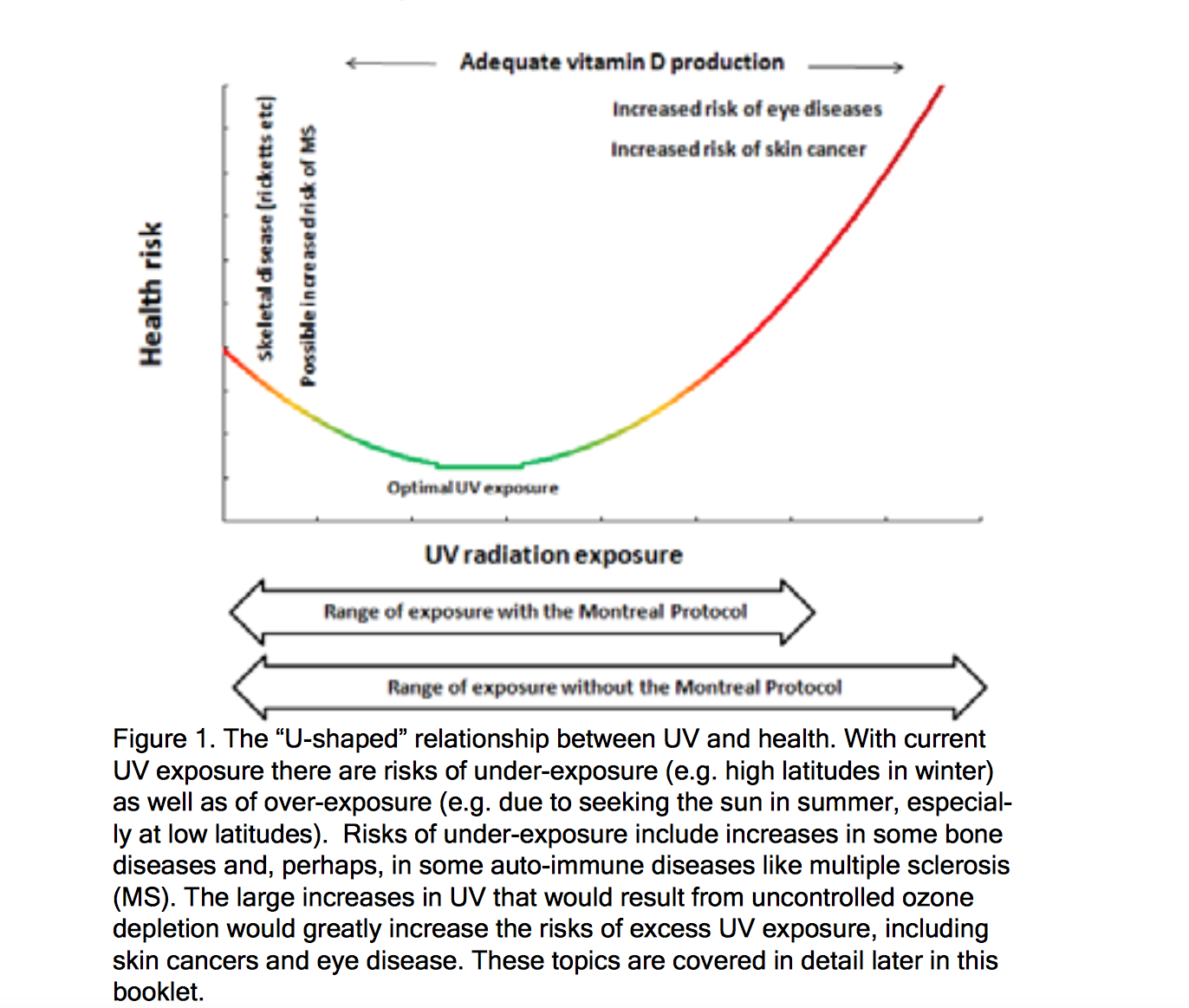
References
The Montreal Protocol and the Human Health (http://www.unep.fr/ozonaction/information/mmcfiles/7738-e-TheMontrealProtocolandHumanHealth.pdf)
ENVIRONMENTAL EFFECTS OF OZONE DEPLETION AND ITS INTERACTIONS WITH CLIMATE CHANGE: 2014 ASSESSMENT (http://ozone.unep.org/Assessment_Panels/EEAP/eeap_report_2014.pdf)
Scientific Assessment of Ozone Depletion: 2014 (https://www.wmo.int/pages/prog/arep/gaw/ozone_2014/documents/Full_report_2014_Ozone_Assessment.pdf).

